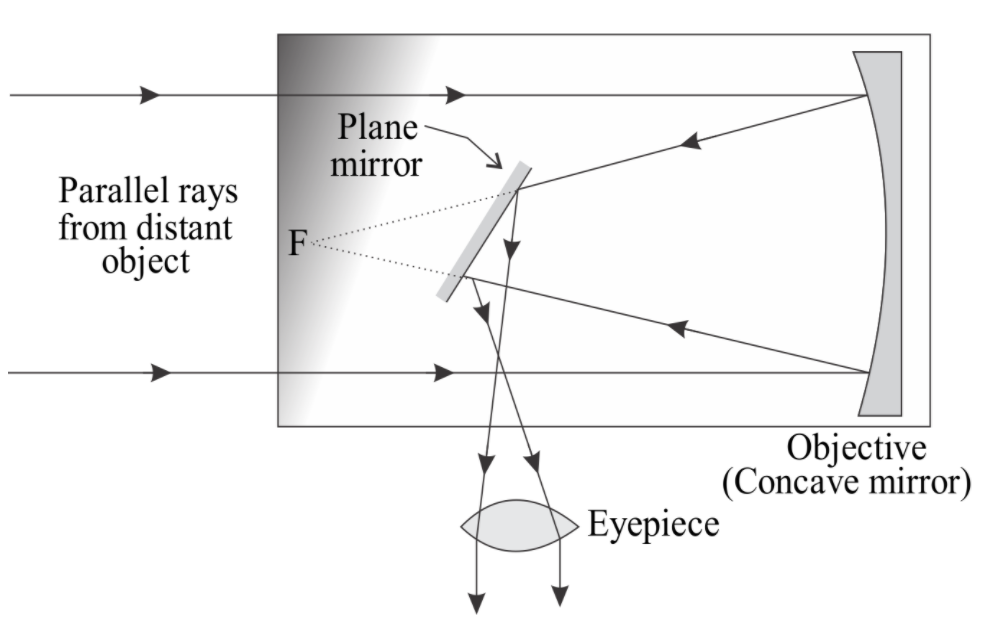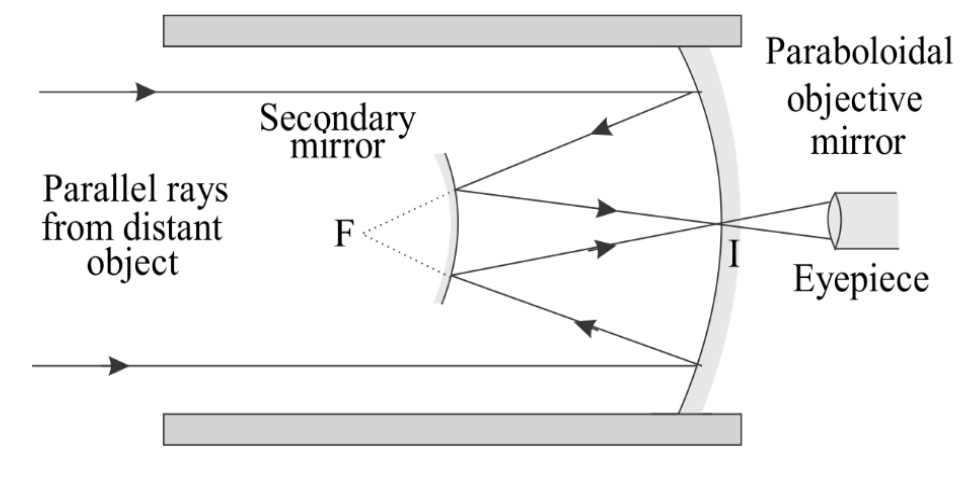
Draw a schematic ray diagram reflecting a telescope showing how rays coming from a distant object are received at eyepieces. Write its two important advantages over a refracting telescope.
Answer
562.8k+ views
Hint: Newton and Cassegrain were the two scientists who gave the idea of reflecting telescopes. This makes use of reflection of light( and its principle) to view the objects in the space.
Complete step by step solution:
Newtonian telescope:

The first reflecting telescope was invented by Newton in 1668. As shown in the above diagram, it consists of a large concave mirror ( working here as objective). A light source emits a beam of light from a distance ( quite large) that is being incident on the objective. Before the rays can be focused at \[F\] (focus), a plane mirror inclined at ${45^\circ }$ interrupts these rays and turns them towards the eye-piece which is adjusted as shown in the picture. The eye-piece forms the image of the distant object.
Cassegrain reflecting telescope :

It is shown in the above picture. It consists of a large paraboloidal mirror(primary ) and a small convex mirror is used as a secondary mirror near the focus of the primary mirror. The eye-piece is placed behind the mirror on its axis of focus. The rays from the distant objects get reflected by a larger mirror ( concave one). They converge towards the focus and are reflected by the secondary mirror and finally converge at $I$ ( as shown in the picture). The final image is viewed through eye-piece .
Advantages of reflecting telescope over refracting telescopes:
1. The mirrors used have large apertures and that is why the reflecting telescope has high resolving power as compared to the refracting ones.
2. The usage of paraboloidal mirrors uses spherical aberration.
Note: The concave mirrors of large apertures have high gathering power, so even with small amounts of light, the objects can be viewed clearly. So even very distant stars( astronomical bodies) can be seen clearly.
Complete step by step solution:
Newtonian telescope:

The first reflecting telescope was invented by Newton in 1668. As shown in the above diagram, it consists of a large concave mirror ( working here as objective). A light source emits a beam of light from a distance ( quite large) that is being incident on the objective. Before the rays can be focused at \[F\] (focus), a plane mirror inclined at ${45^\circ }$ interrupts these rays and turns them towards the eye-piece which is adjusted as shown in the picture. The eye-piece forms the image of the distant object.
Cassegrain reflecting telescope :

It is shown in the above picture. It consists of a large paraboloidal mirror(primary ) and a small convex mirror is used as a secondary mirror near the focus of the primary mirror. The eye-piece is placed behind the mirror on its axis of focus. The rays from the distant objects get reflected by a larger mirror ( concave one). They converge towards the focus and are reflected by the secondary mirror and finally converge at $I$ ( as shown in the picture). The final image is viewed through eye-piece .
Advantages of reflecting telescope over refracting telescopes:
1. The mirrors used have large apertures and that is why the reflecting telescope has high resolving power as compared to the refracting ones.
2. The usage of paraboloidal mirrors uses spherical aberration.
Note: The concave mirrors of large apertures have high gathering power, so even with small amounts of light, the objects can be viewed clearly. So even very distant stars( astronomical bodies) can be seen clearly.
Recently Updated Pages
A man running at a speed 5 ms is viewed in the side class 12 physics CBSE

State and explain Hardy Weinbergs Principle class 12 biology CBSE

Which of the following statements is wrong a Amnion class 12 biology CBSE

Two Planoconcave lenses 1 and 2 of glass of refractive class 12 physics CBSE

The compound 2 methyl 2 butene on reaction with NaIO4 class 12 chemistry CBSE

Bacterial cell wall is made up of A Cellulose B Hemicellulose class 12 biology CBSE

Trending doubts
What are the major means of transport Explain each class 12 social science CBSE

Which are the Top 10 Largest Countries of the World?

Draw a labelled sketch of the human eye class 12 physics CBSE

Explain sex determination in humans with line diag class 12 biology CBSE

The pH of the pancreatic juice is A 64 B 86 C 120 D class 12 biology CBSE

Give 10 examples of unisexual and bisexual flowers




